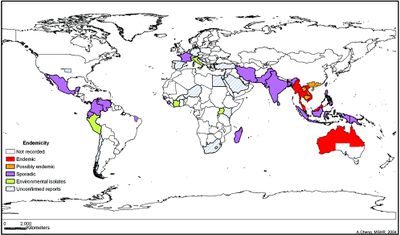Burkholderia pseudomallei infection: Difference between revisions
| Line 36: | Line 36: | ||
==Prevention== | ==Prevention== | ||
Infection by <i>Burkholderia pseudomallei</i> in the endemic regions can be prevented by avoiding contact with soil and standing water, often the modes of transmission. Persons with open skin wounds or diabetes or chronic renal disease are at an increased risk for infection. In endemic areas, agricultural workers should wear boots to prevent infection through the feet and calf. (CDC) Health care professionals who may encounter the disease should take normal precautions. | |||
==Host Immune Response== | ==Host Immune Response== | ||
==References== | ==References== | ||
Revision as of 16:25, 25 July 2014

Etiology/Bacteriology
Taxonomy
| Domain = Bacteria
| Phylum = Proteobacteria
| Class = Betaproteobacteria
| Order = Burkholderiales
| Family = Burkholdiaceae
| Genus = Burkholderia
| species = B. pseudomallei
Description
Pathogenesis
Transmission
Infectious dose, incubation and colonization
Epidemiology

Virulence Factors
Clinical Features
Diagnosis
Diagnosis of Melioidosis is best achieved through the isolation of the organism from a sample taken from the blood, sputum, skin lesion, abscess, or urine. (CDC) The bacteria can be isolated on the Ashdown medium first described by L.R. Ashdown in 1979. (CHENG) The medium contains: tryptase soy agar with glycerol, crystal violet, natural red, gentamicin and colistin. Gentamicin prevents the growth of other organisms, which allows the sample to be taken from non-sterile sites on the patient. (CHENG) Detection of an antibody response to the bacteria is also a form of diagnosis; however isolation of Burkholderia pseudomallei is more commonly used.
Treatment
The course of treatment for Melioidosis is subject to the severity and type of infection. The most common form of treatment begins with intravenous antimicrobial therapy for 10-14 days, followed directly by 3-6 months of oral antimicrobial therapy. (CDC) Two of the most common intravenous antimicrobial medications used are ceftazidime administered every 6-8 hours or meropenem administered every 8 hours. Trimethoprim-sulfamethoxazole or doxycycline may both be used for the oral antimicrobial therapy. (CDC) Alternative treatments are considered in cases of penicillin allergies. Treatment of B. pseudomallei is often dependent on the severity of the infection, as well as, the immunological health of the patient. Patients with diabetes or renal disease are often more susceptible to infection and therefore require a different course of treatment. In terms of respiratory infection, if abscesses develop on the lung after 6 months of positive culture on the lung a lobectomy is performed to remove the abscess. (MEDICINENET)
Prevention
Infection by Burkholderia pseudomallei in the endemic regions can be prevented by avoiding contact with soil and standing water, often the modes of transmission. Persons with open skin wounds or diabetes or chronic renal disease are at an increased risk for infection. In endemic areas, agricultural workers should wear boots to prevent infection through the feet and calf. (CDC) Health care professionals who may encounter the disease should take normal precautions.
